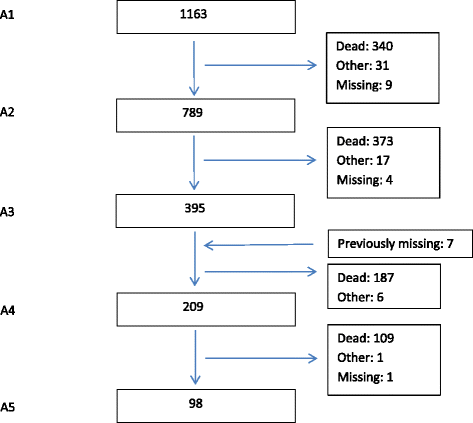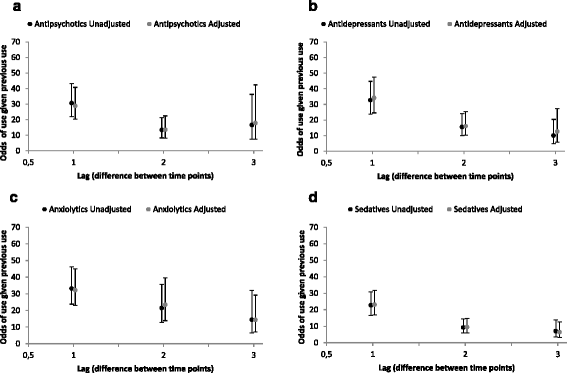Persistent use of psychotropic drugs in nursing home residents in Norway
- PMID: 28193181
- PMCID: PMC5307887
- DOI: 10.1186/s12877-017-0440-5
Persistent use of psychotropic drugs in nursing home residents in Norway
Abstract
Background: The prevalence of psychotropic drug (PTD) use in NH residents is high, but few have explored prevalence and persistency in PTD in NH residents and factors associated with persistency. This at the same time as we know that risk of side events may be higher with long- term use in older adults. Thus, the aim of this study was to describe the prevalence and persistence in use of PTD and to explore factors associated with persistence in use of PTD at two consecutive time points in nursing home (NH) residents.
Methods: We included 1163 NH residents in a 72-month longitudinal study with five assessments. Use of PTD, neuropsychiatric symptoms (NPS), severity of dementia and physical health were assessed each time.
Results: The prevalence over time and persistent use of antipsychotic drugs, antidepressants, anxiolytics and sedatives at two consecutive time points were high in residents with and without dementia. There was an association between greater NPS at the first time point, and persistent use of these drugs, but changes in NPS between time points, did not explain such use. A longer NH stay increased the odds for persistent use of antipsychotics.
Conclusion: Psychotropic drugs are frequently used as a long-term treatment among NH residents and are associated with severity of neuropsychiatric symptoms, but not with severity of dementia. Closer attention should be paid to follow-up of psychotropic drug treatment, and especially for long -term use of antipsychotics, since the duration of such treatment should be as short as possible.
Keywords: ATC; Dementia; Geriatrics; Long-term-use; Neuropsychiatric symptoms; Old age; Older adults.
Figures


Similar articles
-
Prevalence and persistent use of psychotropic drugs in older adults receiving domiciliary care at baseline.BMC Geriatr. 2019 Apr 25;19(1):119. doi: 10.1186/s12877-019-1126-y. BMC Geriatr. 2019. PMID: 31023243 Free PMC article.
-
Does Psychotropic Drug Prescription Change in Nursing Home Patients the First 6 Months After Admission?J Am Med Dir Assoc. 2021 Jan;22(1):101-108.e1. doi: 10.1016/j.jamda.2020.08.034. Epub 2020 Oct 17. J Am Med Dir Assoc. 2021. PMID: 33077352
-
Multi-psychotropic drug prescription and the association to neuropsychiatric symptoms in three Norwegian nursing home cohorts between 2004 and 2011.BMC Geriatr. 2016 Jun 1;16:115. doi: 10.1186/s12877-016-0287-1. BMC Geriatr. 2016. PMID: 27245665 Free PMC article.
-
Prevalence of psychotropic polypharmacy in nursing home residents with dementia: a meta-analysis.Int Psychogeriatr. 2021 Oct;33(10):1083-1098. doi: 10.1017/S1041610220004032. Epub 2021 Jan 7. Int Psychogeriatr. 2021. PMID: 33407955 Review.
-
Prevalence of neuropsychiatric symptoms and psychotropic drug use in patients with acquired brain injury in long-term care: a systematic review.Brain Inj. 2018;32(13-14):1591-1600. doi: 10.1080/02699052.2018.1538537. Epub 2018 Oct 29. Brain Inj. 2018. PMID: 30373405
Cited by
-
Chemical restraint as behavioural euthanasia: case studies from the Royal Commission into Aged Care Quality and Safety.BMC Geriatr. 2023 Jul 19;23(1):444. doi: 10.1186/s12877-023-04116-5. BMC Geriatr. 2023. PMID: 37468889 Free PMC article.
-
The process of pain assessment in people with dementia living in nursing homes: a scoping review.Palliat Care Soc Pract. 2025 Jan 6;19:26323524241308589. doi: 10.1177/26323524241308589. eCollection 2025. Palliat Care Soc Pract. 2025. PMID: 39776523 Free PMC article.
-
A retrospective comparison of inappropriate prescribing of psychotropics in three Norwegian nursing homes in 2000 and 2016 with prescribing quality indicators.BMC Med Inform Decis Mak. 2019 May 29;19(1):102. doi: 10.1186/s12911-019-0821-0. BMC Med Inform Decis Mak. 2019. PMID: 31142298 Free PMC article.
-
Variation between nursing homes in drug use and in drug-related problems.BMC Geriatr. 2020 Sep 9;20(1):336. doi: 10.1186/s12877-020-01745-y. BMC Geriatr. 2020. PMID: 32907532 Free PMC article.
-
Use of Central Nervous System (CNS) Medicines in Aged Care Homes: A Systematic Review and Meta-Analysis.J Clin Med. 2019 Aug 23;8(9):1292. doi: 10.3390/jcm8091292. J Clin Med. 2019. PMID: 31450830 Free PMC article.
References
-
- Huber M, et al. Antipsychotic drugs predominate in pharmacotherapy of nursing home residents with dementia. Pharmacopsychiatry. 2012;45:182–8. - PubMed
MeSH terms
Substances
LinkOut - more resources
Full Text Sources
Other Literature Sources
Medical
Research Materials

